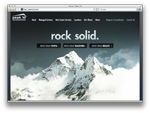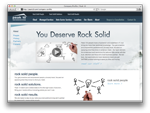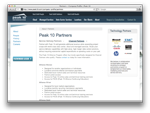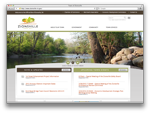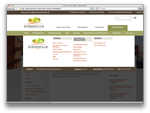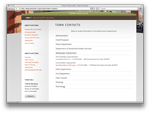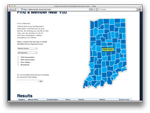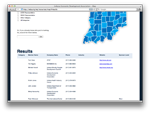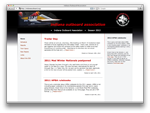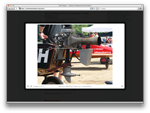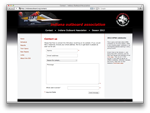These are the things I have done
Below is a sample of some of the work I have done professionally over the past few years. I did not do any design work and consulted with the people who designed these sites through the development process. At MediaSauce, I had a great deal of autonomy and responsibility over my work but I also relied on the expertise of my coworkers to help me through problems.
-
Lunar ISRU for building solar power satellites (August 2017 - Present)
Part of an multidisciplinary team to study feasibility of using lunar regolith to build solar power satellites and move them to geosynchronous orbit in automated process
Abstract to be presented at International Moon Base Summit in October 2017
Research will be compiled into paper to be submitted to AIAA for publication
-
Senior Physics Capstone (May 2015 - December 2015)
Title: Analaysis of the physical parameters of a Dyson Sphere
A Dyson Sphere is a possible artifact left behind by extremely advanced civilization. This was my senior capstone project for my Bachelor of Science degree in Physics from Purdue University at Indianapolis.
A Dyson Sphere seemed like an interesting subject to consider and to apply some of what I learned as a Physics major. Put simply, a Dyson Sphere is a shell that completely encloses as star. I wanted to know how big such an object would be and how thick the shell must be to approximate Earth’s surface temperature and gravity on the outside.
While this project could have been done with calculus, it was not necessary. It required knowledge of the star’s luminosity, radius, and mass and the sphere’s material density and thermal conductivity.
Putting all of these variables together led to a relationship that described the sphere’s physical parameters, depending on the its material and parent star. For some idea, I assumed the sphere would be made of iron, since that is the most common material found in rocky planets and asteroids. For the star, I started with the smallest possible red dwarf, since that would be the easiest star to build around.
You can read the paper in PDF format.
-
SEDS (August 2015 - Present)
Title: Problem-based Multi-disciplinary Participation in Aerospace Design
Presenting own part at American Institute of Aeronautics and Astronautics Region III conference on April 1, 2016.
I am participating in a student group at IUPUI, Students for the Exploration and Development of Space (SEDS). We collectively agreed to do this project after considering the list of themes on the RASC-AL website.
The goal is to design an Earth-independent space station that can function for at least 20 years without resupply and for it to generate its own gravity by rotating. Launch, construction, and all other phases of the project must be accomplished within NASA’s current budget, excluding Space Launch System, Orion, and International Space Station operations.
My section was on launch vehicles and launch logistics. Essentially, I was responsible for analyzing current and anticipated American launch vehicles, namely Falcon 9, Falcon Heavy, Atlas V, Delta IV, SLS, and Vulcan, to determine which would be most efficient and cost-effective for launching the station components. This was done in coordination with the other groups, who determined how large and massive these station components would need to be to meet the design goals.
At the group’s faculty sponsor’s advice, I decided to take this research a step further and apply bin-packing methodologies to optimize launches. Some of this work was done manually, for example, separating the 5-meter diameter modules from the rest and using MATLAB to do the rest of the work. At the time of this application, this project is ongoing and the final draft will be submitted to the AIAA for consideration by March 18. The group project will be presented at the American Society for Engineering Education conference in New Orleans in June 2016.
-
Launch azimuth calculator (August 2015)
I created a small Python module based on numpy to be used as a command line tool for calculating launch azimuths for Kerbal Space Program quickly. I included physical constants for Earth and the planet Kerbin, found in KSP.
The script accepts arguments for target altitude, target inclination, and launch site latitude. It outputs the two possible launch azimuths and how much delta-v would be saved.
-
Tesla charge port opener (January 2016 - Present)
Arduino-based project with code written in C++
This project uses a 315-MHz transmitter, triggered by a simple push button to send out a hard-coded byte code to cause a Tesla Model S to open its charge port.
This project sprang from my interest in the OpenEVSE project. I wanted to come up with a modification to the standard OpenEVSE kit that would make using it more convenient for Tesla Model S and Model X owners, as the standard SAE J1772 connector does not have the RF transmitter included in the Tesla connector.
I started this project and learning about the J1772 standard because I love electric vehicles and I wanted to learn more about electronic signaling processing than was covered in my laboratory course work.
-
Website for Indiana Outboard Association (April 2008 - November 2015)
Built and maintained a website for a regional non-profit boat racing club
Wrote a custom WordPress theme to convert a website of static HTML files to one that could be easily maintained by other members of the organization
Used legacy graphic files from the original IOA website to make the new theme resemble an earlier version of the site, but still be modern, flexible, interactive, and polished
Set up cron job to trigger a shell script every week that would pull the most recent version of the WordPress theme's code to keep it up to date
-
Outboard hydroplane racing (May 2001 - Present)
Worked on modified 2-stroke OMC and Yamato outboard motors.
I went to my first boat race in 1993 and started racing in 2001. I have raced every year since then.
My father and I do all of our own work on our equipment. As of March 2016, I am in the process of changing piston rings on my engine for the coming racing season. It should be done every year or so.
To get the best possible performance, I test different propellers and equipment settings. One modification made was to redirect water away from the exhaust megaphone to keep it hotter than it normally is. This produced a 1-2 MPH improvement in top speed.
I am involved with a non-profit club called in the Indiana Outboard Association (IOA) and our events are sanctioned through the American Power Boat Association (APBA). I race in 200cc Modified Hydroplane, which is in the APBA’s Modified Outboard category. This is amateur racing, but there are national points and champions are recognized nationally.
In 2010, I took the APBA’s National High Point Championship in my class for having accumulated more points over the season than anyone else in the country.
In 2012, the IOA gave me the Pit Person of the Year award for voluntarily setting up and tearing down the club’s starting clock and other equipment at the APBA Mod Outboard Nationals in Rainbow City, AL that year. This helped the Nationals run smoothly for everyone and kept the equipment in good shape for our next race.
In 2014, I won the IOA’s Sallee Award, which goes to the IOA member who accumulated the highest number of points while running only one class. This requires a commitment to only one class when it is commonplace to run multiple classes in a weekend of racing.
-
Science Olympiad Volunteering (March 2012 - Present)
For three (soon to be four) years, I have volunteered at the Indiana Science Olympiad competition held at Indiana University - Bloomington.
I have monitored testing and building events to make sure everyone has a fair shot. I would typically show up
I enjoyed Science Olympiad when I was in high school and I want to help make it a fun experience for others, too.
-
Peak 10 (November 2011)
Work completed with MediaSauce
Peak 10 is a hosting company located in the southeastern United States.
I participated in developing this site, alongside the rest of the MediaSauce development team. I took my directions from the senior-level developer who managed the creation of this site. Working on this and another site, just prior to the Peak 10 project, gave me a crash course in ExpressionEngine.
-
Town of Zionsville (April 2011)
Work completed with MediaSauce
I took ownership of developing a website on top of WordPress to promote the town of Zionsville, Indiana. I was assisted, especially in the revision stage by other MediaSauce developers.
This site featured a large, complex drop-down navigation menu, with links to all top-level site pages and all sub-pages belonging to the various town services.
-
Indiana Economic Development Association (November 2010)
Work completed with MediaSauce
This is a website for an organization that seeks to draw new business to the state of Indiana and keep it here. I took the lead on developing this website, with some assistance from the rest of the MediaSauce Interactive Team.
This site was built with WordPress. It mostly kept to the standard WordPress scheme, utilizing posts and pages and using category pages to organize the posts.
The part of the site that required the most work and provided the most interactivity was the map of Indiana. It required creating an image map of all 92 of Indiana's counties. Clicking on a county will filter a list of businesses and organizations that participate with IEDA.
-
Indiana Outboard Association (March 2008 – present)
Work completed with Tom McCain
Website to promote amateur outboard boat racing group with members in Indiana, Michigan, Ohio, and Illinois. I worked with a local web designer and illustrator to take ownership over a site that he had designed and maintained.
Originally, this site was a series of static HTML pages and it was difficult to keep content consistent and up-to-date. I overhauled the site in October 2010 to run on top of WordPress.
